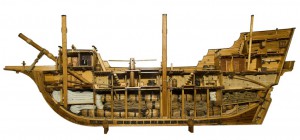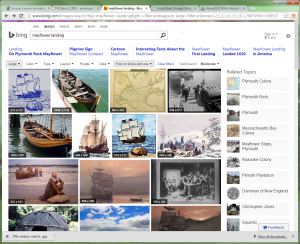 When working on a family history, we like to include historic images and photos of places and events as well as photos from family collections. More and more, we’re using both Google and Bing image searches to kick-start our efforts. More and more, I’m coming to prefer Bing.
When working on a family history, we like to include historic images and photos of places and events as well as photos from family collections. More and more, we’re using both Google and Bing image searches to kick-start our efforts. More and more, I’m coming to prefer Bing.
Both sites provide helpful search filters. On the Google.com or Bing.com main page, enter your search term, and click Images. Once your results appear, as image thumbnails, you can refine further: sorting for size (choosing “large” to ensure a high-resolution image), for license/permission, for type (photo vs. line art), and so on. Bing goes even further, which is why I have come to prefer it. Specifically, it automatically gives me a list of subtopics, as well as a list of related topics.
I decided to try a search of “Mayflower landing,” as we’re always seeking a new way to illustrate it without using something hokey or overused.
The first hits resulting from a Google image search, filtered for “large” and “labeled for reuse,” included the following: a cross-section of a comparable ship of the era; a color postcard with a painting of the Mayflower approaching land – definitely in the hokey category; an interesting painting, The Landing of the Pilgrims, by Michele Felice Cornè, which is in the White House collection; and a photo of a sloop built in 1880 – clearly not the Mayflower. Further investigation, however, shows that paintings in the White House’s collection require permission to reproduce.
The first hits resulting from a Bing image search, filtered for “large” and “free to share and use,” included a kind of silkscreen image of the Mayflower; a photo of the Mayflower II; a map showing the Mayflower’s voyage; and, oddly, a photo of President and Mrs. Coolidge arriving at Plymouth Rock. Maybe nothing right there, but Bing gives me the following possible subtopics: Landing on Plymouth Rock Mayflower; Pilgrims Sign Mayflower Compact; Cartoon Mayflower; Interesting Facts about the Mayflower; and Mayflower Landed 1620. Related topics include Plymouth Colony; Plymouth Rock; Plymouth; Massachusetts Bay Colony; Plimoth Plantation; and others. “Cartoon Mayflower” excepted, most of these ultimately lead to interesting images.
Result: This match goes to Bing, thanks to its assistance with search refinement. However, I’m intrigued by the Cornè paining that appears only on Google. I just might want to write to the White House about getting permission to use it!
Share this:
About Penny Stratton
A veteran of the book publishing industry, Penny Stratton retired as NEHGS Publishing Director in June 2016; she continues to consult with the Society on publications projects. Among the more than 65 titles she managed at NEHGS are The Great Migration Directory, Elements of Genealogical Analysis, Genealogist’s Handbook for New England Research, and the award-winning Descendants of Judge John Lowell of Newburyport, Massachusetts. She has written for American Ancestors magazine and is a regular poster on Vita Brevis. With Henry B. Hoff, Penny is coauthor of Guide to Genealogical Writing: How to Write and Publish Your Family History; she is also the author of several Portable Genealogists on writing and publishing topics.View all posts by Penny Stratton →
